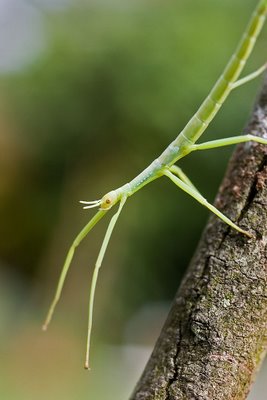

These two phasmids (stick insects) are the same species. In fact they're probably siblings. And surprisingly, they're about three years old.
I keep another species of phasmid, the spiny leaf insect (Extatosoma tiaratum), and I was quite surprised a few weeks ago when I had hatchlings emerging from the container with this species in it that were obviously not Extatosoma. Thinking back, the only source of the eggs of this species that I can think of was from some adults I collected from the snowy mountains in the summer of 2003. I must have just thrown the eggs in with my Extatosoma eggs, and now, three years on, they've decided to hatch. Unfortunately I don't know what species they are - when they become adults I should be able to find out.
The really interesting thing about these nymphs is that they show what's referred to as 'kentromorphic' phase change. If an individual grows up in isolation or low density, it will display a cryptic uniform green colouration. If it's in high density however, it turns the colour of the one on the right above - that is highly contrasting black, yellow and white. That's classic warning colouration.
Locusts show a similar phenomenon. Green when solitary, yellow and black when crowded. The interesting thing is that both locusts and some phasmid species (including the ones showing kentromorphic phases) plague. That is to say the population occasionally skyrockets and you've got a swarm of hungry locusts or phasmids on the move as they deplete local food sources.
So these insects seem to use their colours in quite different ways. When the population density is low, being conspicuous isn't a good idea - predators may not encounter the insects often enough to learn to avoid the aposematic signal, so it's better to remain camoflagued. But when there are heaps of conspecifics around, predators will get the message pretty quickly and there's a real benefit to advertising unpalatability.
References:
Key, K. H. L. 1957. Kentromorphic phases in three species of phasmatodea. Australian Journal of Zoology 5:247-284.
http://home.swiftdsl.com.au/~pmiller/stick_insects/papers/key1957/index.html



No comments:
Post a Comment